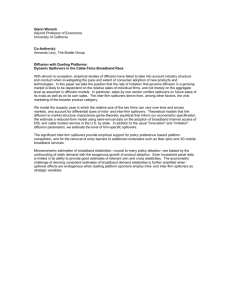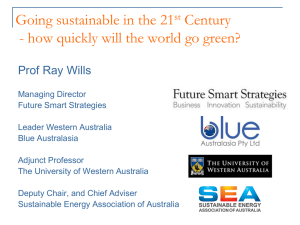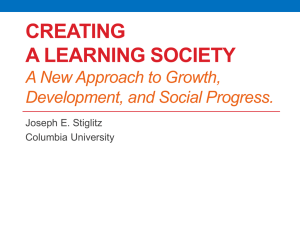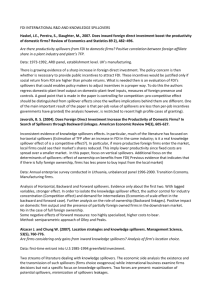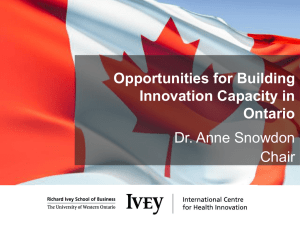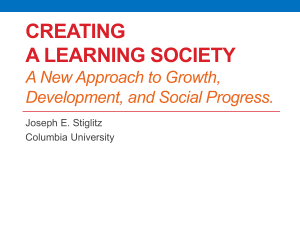Diffusion & Social Returns - Princeton University Press
advertisement
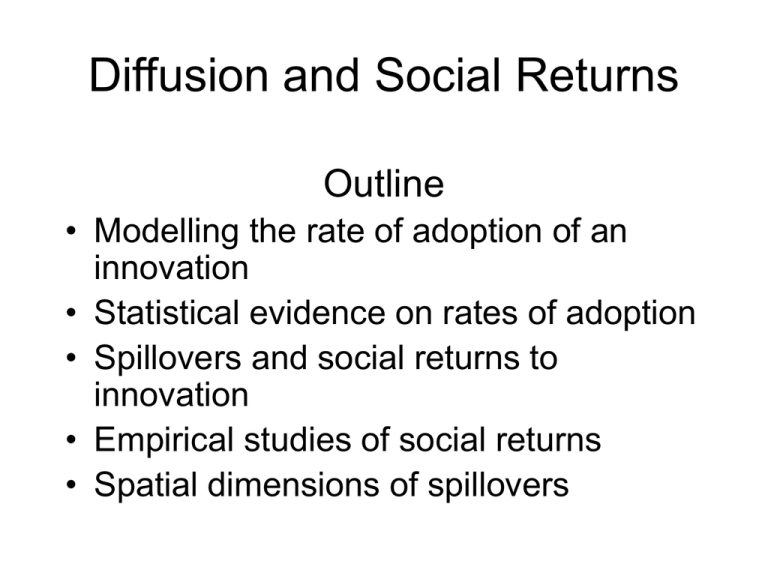
Diffusion and Social Returns Outline • Modelling the rate of adoption of an innovation • Statistical evidence on rates of adoption • Spillovers and social returns to innovation • Empirical studies of social returns • Spatial dimensions of spillovers What is diffusion? Diffusion involves: • Transfer of information to customers about innovations • Decisions by buyers to adopt the innovative product or process • Eventual saturation of the market by the new generation of products or processes • Then there is full realization of Schumpeter’s process of creative destruction Modelling the rate of adoption of an innovation • Biological approach – an epidemic model – random encounters cause transfer of information (analogy with catching disease) • Once information has been transmitted there is a fixed probability of the potential new customer deciding to buy the innovation • A few early adopters, then an epidemic • Lastly the few laggards adopt, so reach saturation in the market • Rate of adoption follows a bell-shape so cumulative proportion is an S-shape The cumulative path of adoption for an epidemic model D 1 Saturation Cumulative number of adopters (as proportion) ½ 0 Point of inflexion Time Economic model of diffusion • Introduce prices, costs of adoption, tastes • Only adopt when net gain is positive, taking account of all these factors • Formally differentiate customers by variety of taste and cost characteristics (indexed by Z) • Distribution of Z is bell-shaped (e.g. Normal) • As product price falls (or costs of adoption fall) then over time those with less favourable Z values will find it worthwhile to adopt • Again cumulative rate of adoption S-shaped How characteristics (index Z) determine the rate of adoption Frequency f(Zi) Do not adopt Adopt Z* Zi Index of adoption Network and lock-in effects • Network effects arise whenever there are gains to using the same products or technologies that others are using • Lock-in occurs when once consumer adopts one system it costs a lot to change to another - examples QWERTY and videos • Can be due to need for interoperability and/or to users’ learning investments • Market failure occurs if the first system to gain critical mass becomes the standard, even if does not have the best overall product characteristics Statistical evidence on rates of adoption • Process of reaching market saturation is slow and often incomplete • This is demonstrated for older manufacturing technologies in Figure 7.3 (not shown here due to limitation of copyright license!) • Slow pattern of adoption is also seen in information and communications technology • Examples are: (see Tables 7.1 and 7.2) use of computers in process technology use of Internet across countries Spillovers and social returns to innovation Three beneficiaries from positive externalities of innovation: • Final consumers - Consumer welfare rises as product price falls or product quality rises • Competing firms in industry Knowledge spillovers inform their production Licensing technology can improve their profitability • Firms in other industries - Reduced input costs and/or better input variety Methods of assessing spillovers Input–Output Method: • Models the whole economy • Traces flows of intermediate products between firms in same and different sectors to see who buys what • Innovations that are produced in one sector flow out to all their buyers in other sectors Econometric studies • These studies use firm or industry data • Assess how a rise in innovation in one firm/sector affects performance in another Empirical studies of social returns – input-output evidence • Input-output studies are able to identify significant differences between sectors in their roles as innovation producers and as innovation users • For the US see study by Scherer • For the UK see study by Greenhalgh and Gregory • Both innovation producers and users contribute to the diffusion of returns to final consumers Empirical studies of social returns – micro evidence • Econometric micro-analysis indicates that knowledge spillovers are substantial • This implies that policies to encourage innovation and R&D are justified. • Knowledge spillovers are influenced by level of absorptive capacity of receiving firms • Conducting R&D can increase a firm’s absorptive capacity • Policy to encourage R&D thus improves “the two faces of R&D” Spatial dimensions of spillovers If spatial spillovers are instantaneous and complete: • Countries lagging behind technology frontiers would catch up quickly showing high growth • Less incentive exists for subsidising domestic R&D as the benefits diffuse to other countries • Evidence that the spatial proximity is still important in knowledge spillovers • Spillovers from R&D diminish with distance across major countries • Studies of patent citations show: more likely to be citing domestic than foreign patent more likely to be citing patent from same region Questions for discussion 1. Why is diffusion generally a slow process? 2. Are there cases when the epidemic model is better than the economic model? 3. What factors speed up or slow down the adoption of new technology by industry? 4. Should policy be concerned about ‘lock-in’ or ‘network effects’? 5. What lessons can be learnt from input-output analysis of R&D and innovation? More difficult questions 6. Choose an innovation you are familiar with and outline the potential customers and firms affected by it. How would you attempt to quantify these effects? 7. Define a) knowledge spillovers and b) business stealing. How could one test the relative importance of each? 8. What are hedonic price indices? Are they important? 9. What lessons should policymakers learn from the economics of diffusion? References • Gold, B., W. S. Peirce and G. Rosegger (1970), 'Diffusion of major technological innovations in U.S. iron and steel manufacturing', Journal of Industrial Economics, July. • Scherer, F M (1984), Innovation and Growth: Schumpeterian Perspectives, Cambridge Mass., MIT Press. • Greenhalgh, C and M Gregory (2000) ‘Labour productivity and product quality: their growth and inter-industry transmission’, Ch.3 of R. Barrell, G. Mason and M. O’Mahoney (eds.), Productivity, Innovation and Economic Performance, Cambridge U.P. • Bloom, N., M. Shankerman and J. Van Reenen (2007), 'Identifying technology spillovers and product market rivalry', NBER Working Paper 13060.
